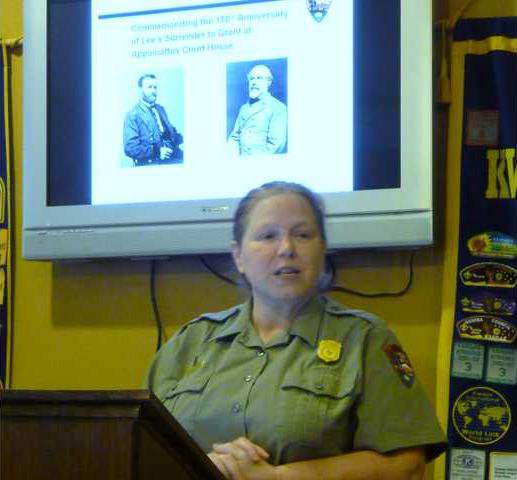On April 9, 1865, the surrender of the Army of Northern Virginia in the McLean House in the village of Appomattox Court House, Virginia, signaled the end of the Civil War.
National Historic Parks across the nation celebrated the 150th anniversary of the surrender last month, including the Fort Larned National Historic Site in Pawnee County. Fort Larned and the churches in the city of Larned rang their bells at 2:15 p.m. on April 9th, and Park Ranger Celeste Dixon, who worked at Appomattox Court House NHP before transferring to Fort Larned, presented a special program on the surrender meeting the night before.
Dixon visited the Great Bend Noon Kiwanis Club on Wednesday with a short version of her program.
People sometimes assume the surrender took place at a courthouse, but Appomattox Court House refers to the name of the city, as was once customary for county seats in the South, Dixon explained. The surrender, which prompted the end of the Civil War, took place in the McLean House, after two days of Grant and Lee exchanging letters.
Lee wanted to meet with Grant to talk about peace, but Grant was only authorized to talk about terms of surrender. “He knew that President Lincoln didn’t want his generals dabbling in politics,” Dixon said.
For Fort Larned history buffs, there are some connections to the surrender and George Armstrong Custer, who arrived at Fort Larned in 1867.
As Grant pursued Lee’s Army of Northern Virginia west from Richmond, Virginia, Lee tried to pick up supplies at Appomattox Court House, but the supplies were captured by Union forces under the command of Custer.
There are some accounts that put Custer in the McLean House at the surrender, but Dixon said a more reliable source is a soldier’s diary from time of the events. The soldier wrote he and Custer were together by the river when they heard the surrender had happened.
Those who were at the McLean House helped themselves to souvenirs, and Gen. Phillip H. Sheridan, who was at the meeting, rewarded Custer with a small table from the house for his part in the military actions.
For more information on the surrender on the Internet, visit the National Park Service site: http://www.nps.gov/apco/the-meeting.htm.
Civil War program presented





